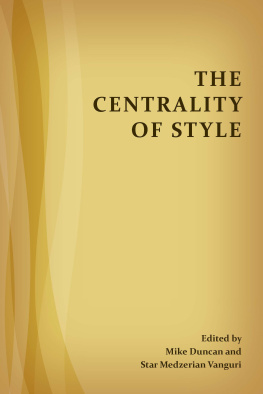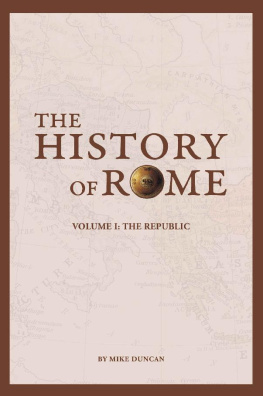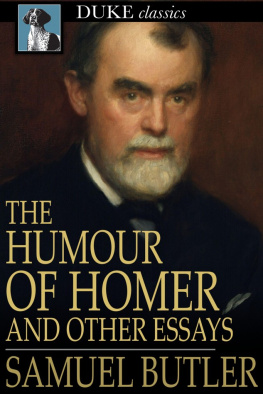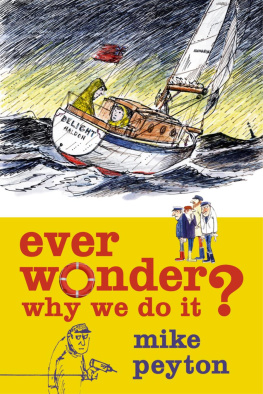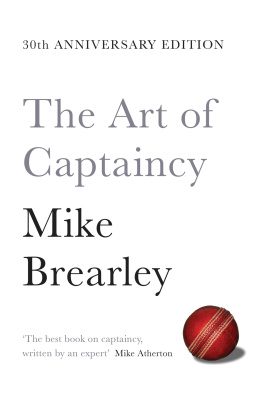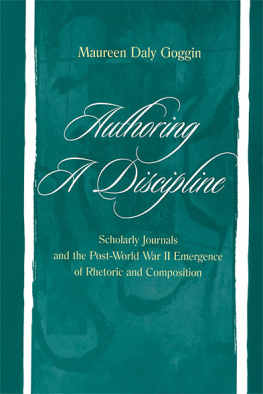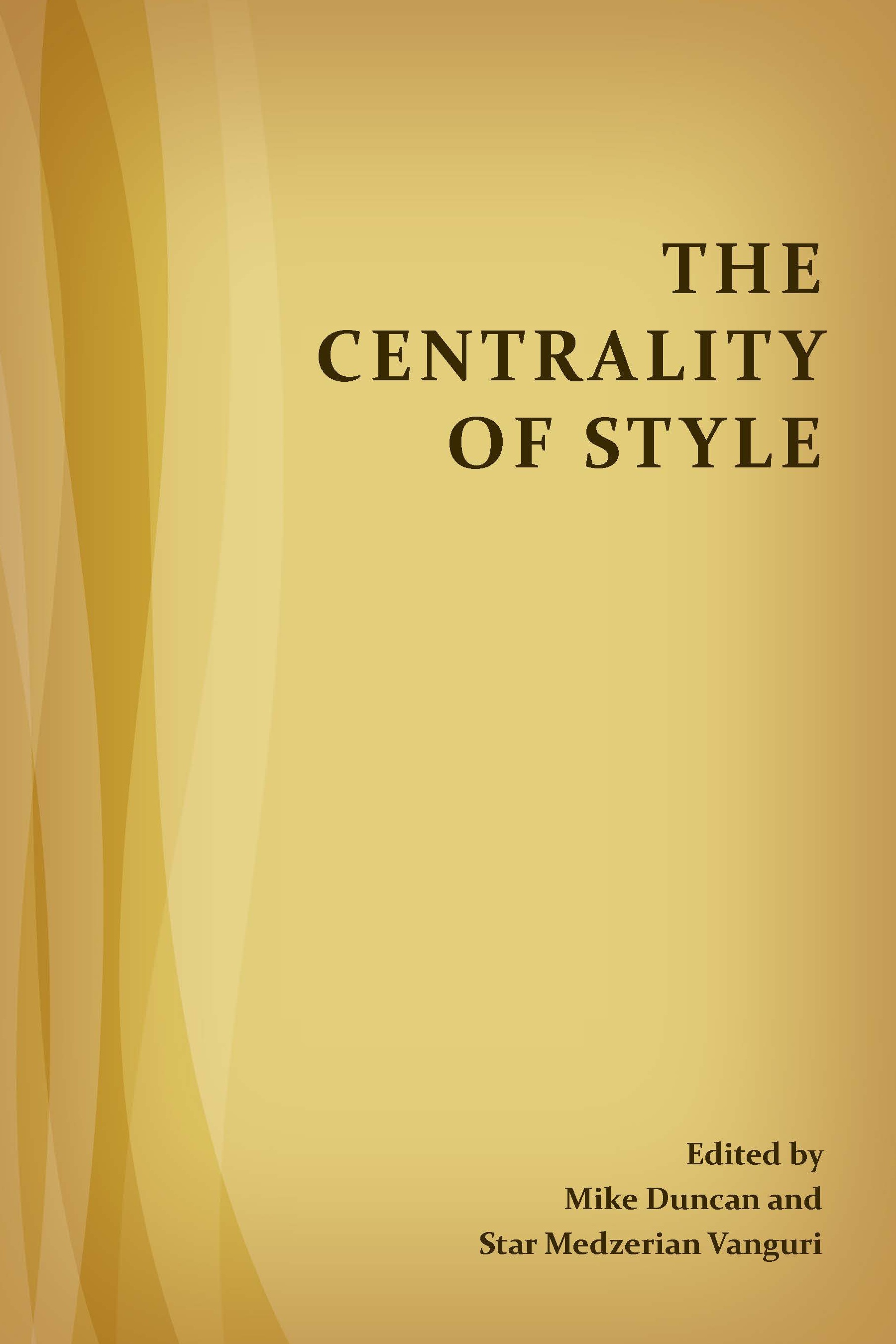THE CENTRALITY OF STYLE
Edited by Mike Duncan and Star Medzerian Vanguri
The WAC Clearinghouse
Fort Collins, Colorado
Parlor Press
www.parlorpress.com
Anderson, South Carolina
PERSPECTIVES ON WRITING
Series Editor, Susan H. McLeod
The Perspectives on Writing series addresses writing studies in a broad sense. Consistent with the wide ranging approaches characteristic of teaching and scholarship in writing across the curriculum, the series presents works that take divergent perspectives on working as a writer, teaching writing, administering writing programs, and studying writing in its various forms.
The WAC Clearinghouse and Parlor Press are collaborating so that these books will be widely available through free digital distribution and low-cost print editions. The publishers and the Series editor are teachers and researchers of writing, committed to the principle that knowledge should freely circulate. We see the opportunities that new technologies have for further democratizing knowledge. And we see that to share the power of writing is to share the means for all to articulate their needs, interest, and learning into the great experiment of literacy.
Other Books in the Series
Charles Bazerman, Adair Bonini, and Dbora Figueiredo (Eds.), Genre in a Changing World (2009)
David Franke, Alex Reid, and Anthony Di Renzo (Eds.), Design Discourse: Composing and Revising Programs in Professional and Technical Writing (2010)
Martine Courant Rife, Shaun Slattery, and Dnielle Nicole DeVoss (Eds.), Copy(write): Intellectual Property in the Writing Classroom (2011)
Doreen Starke-Meyerring, Anthony Par, Natasha Artemeva, Miriam Horne, and Larissa Yousoubova, Writing in Knowledge Societies (2011)
Andy Kirkpatrick and Zhichang Xu, Chinese Rhetoric and Writing: An Introduction for Language Teachers (2012)
Chris Thaiss, Gerd Bruer, Paula Carlino, Lisa Ganobcsik-Williams,
and Aparna Sinha (Eds.), Writing Programs Worldwide: Profiles of Academic Writing in Many Places (2012)
Charles Bazerman, Chris Dean, Jessica Early, Karen Lunsford, Suzie Null, Paul Rogers, and Amanda Stansell (Eds.), International Advances in Writing Research: Cultures, Places, Measures (2012)
Publication Information
The WAC Clearinghouse, Fort Collins, Colorado 80523-1052
Parlor Press, 3015 Brackenberry Drive, Anderson, South Carolina 29621
2013 by Mike Duncan and Star Medzerian Vanguri. This work is licensed under a Creative Commons Attribution-Noncommercial-No Derivative Works 3.0 United States License.
Printed in the United States of America.
Library of Congress Cataloging-in-Publication Data
The centrality of style / edited by Mike Duncan and Star Medzerian Vanguri.
pages cm. -- (Perspectives on writing)
Includes bibliographical references.
ISBN 978-1-60235-422-7 (pbk. : alk. paper) -- ISBN 978-1-60235-423-4 (hardcover : alk. paper)
1. English language--Style. I. Duncan, Mike, 1975- editor of compilation. II. Vanguri, Star Medzerian, 1980- editor of compilation.
PE1421.C46 2013
808.0420711--dc23
2013011457
Copyeditor: Don Donahue
Designers: Mike Palmquist
Series Editor: Susan H. McLeod
The WAC Clearinghouse supports teachers of writing across the disciplines. Hosted by Colorado State University, it brings together scholarly journals and book series as well as resources for teachers who use writing in their courses. This book is available in digital format for free download at .
Parlor Press, LLC is an independent publisher of scholarly and trade titles in print and multimedia formats. This book is available in paperback, cloth, and Adobe eBook formats from Parlor Press at .
Contents
The Centrality of Style
Foreword
Paul Butler
University of Houston
The Centrality of Style presents readers with a paradox. The editors begin with the convincing argument that style must be regarded as central to the discipline of composition studies. Indeed, the collections rich diversity of chapters reasserts the prominent place of style in the field from different perspectives, historical moments, and theoretical and pedagogical approaches.
Yet despite the books claim of styles centrality, it makes an equally forceful casewhich may appear contradictory at firstthat some of the most exciting new ideas in stylistic study have emerged not from the center but the margins of the fieldand the margins intersections with other disciplines, ideas, cultures, and sites of inquiry.
The paradox inherent in the tension of seeing style as both central and marginal is not new to those in rhetoric and composition. Mikhail Bakhtin (1981) has described a similar phenomenon in discussing the clash of languages unifying, or centripetal forces, and their counterpartthe dispersing, or centrifugal forces that often disrupt prevailing norms. In public sphere theory, critical theorist Michael Warner (2005), borrowing from Jurgen Habermas (1989) and others, depicts an identical discordance in the tension between publics that dominate social discourse and their counterpart, a culturally less powerful, oppositional group, called a counterpublic , which constantly works against that dominance even as it maintains, says Warner, at some level, conscious or not, an awareness of its subordinate status (p. 119). With respect to counterpublics, Warner says it is the oppositional aspect of their style that performs membership (p. 142).
There is no question that The Centrality of Style navigates the push and pull of these kinds of oppositions in compelling new ways. The real question is, How does the volume manage to position style in the field as what Frank Farmer (2008), borrowing from anthropologist Victor Turner, calls a liminal counterpublic , emanating from the break or rupture of the public-counterpublic relationship that somehow exists betwixt and between the two? How, in other words, does styles very centrality depend on its marginalization, lack of power, and sometimes renegade status (Johnson, 2003) both inside, and outside, the field?
Some answers to that question, and paradox, can be found in this volume. While there are many examples throughout the collection, here are some of the representative concepts that suggest even larger ideas in The Centrality of Style and show the current push and pull of styles liminal status in the field.
Style as Lingua Franca
In his article in this volume, William FitzGerald argues that [s]tyle has become a contemporary lingua franca , and he gives evidence of the centrality of style historically, in popular culture, and in what he calls the return of the figurative. Yet even as he restores style to a pivotal location in composition and rhetoric, FitzGerald makes a parallel move of relocating style at the peripherymarginalized, he says, by the continuing struggle of the figures of speech for disciplinary legitimacy and for circulation among a broader writing public. Thus, in a move widely used by the writers in this volume, FitzGerald shows the value of style as a common language while maintaining its status as marginal in working toward broader recognition. FitzGerald intimates that both moves are necessary in forging a unique place for style in the field, betwixt and between other disciplinary forces and interests.
A similar move in situating style as liminal is made by Keith Rhodes, who argues, on the one hand, for an aesthetics of style that he sees as persuasively influential but also recognizes, on the other hand, as problematized by the conserving and regressive power of monologic forms of art. Thus Rhodes suggests that having an art of writing, with style at the center, remains elusive, on the margins of the field, as we hesitate to embrace an aesthetics that includes nonlinear or affective influences. Rhodes thus demonstrates the complicated aspect of style as a lingua franca for composition studies.

